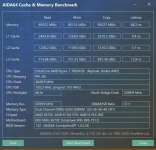| Item | Slot #1 | Slot #2 | Slot #3 | Slot #4 |
|---|
| Ram Type | DDR5 | DDR5 | Not Populated | Not Populated |
| Maximum Clock Speed (MHz) | 3610 (XMP) | 3610 (XMP) | | |
| Maximum Transfer Speed (MT/s) | DDR5-7220 | DDR5-7220 | | |
| Maximum Bandwidth (MB/s) | PC5-28800 | PC5-28800 | | |
| Memory Capacity (MB) | 16384 | 16384 | | |
| DIMM Temperature | 34.000 | 32.000 | | |
| Jedec Manufacture Name | Team Group Inc. | Team Group Inc. | | |
| Search Amazon.com | Search! | Search! | | |
| SPD Revision | 1.0 | 1.0 | | |
| Registered | No | No | | |
| ECC | No | No | | |
| On-Die ECC | Yes | Yes | | |
| DIMM Slot # | 1 | 2 | | |
| Manufactured | Week 49 of Year 2024 | Week 49 of Year 2024 | | |
| Module Part # | UD5-7200 | UD5-7200 | | |
| Module Revision | 0x0 | 0x0 | | |
| Module Serial # | 01045FD1 (04ef00244901045fd1) | 01045FD4 (04ef00244901045fd4) | | |
| Module Manufacturing Location | 0 | 0 | | |
| # of Row Addressing Bits | 16 | 16 | | |
| # of Column Addressing Bits | 10 | 10 | | |
| # of Banks | 32 | 32 | | |
| # of Ranks | 1 | 1 | | |
| Device Width in Bits | 8 | 8 | | |
| Bus Width in Bits | 32 | 32 | | |
| Module Voltage | 1.1V | 1.1V | | |
| CAS Latencies Supported | 22 28 30 32 36 40 42 46 50 | 22 28 30 32 36 40 42 46 50 | | |
| Timings @ Max Frequency (JEDEC) | 46-46-46-90 | 46-46-46-90 | | |
| Maximum frequency (MHz) | 2800 | 2800 | | |
| Maximum Transfer Speed (MT/s) | DDR5-5600 | DDR5-5600 | | |
| Maximum Bandwidth (MB/s) | PC5-22400 | PC5-22400 | | |
| Minimum Clock Cycle Time, tCK (ns) | 0.357 | 0.357 | | |
| Minimum CAS Latency Time, tAA (ns) | 16.428 | 16.428 | | |
| Minimum RAS to CAS Delay, tRCD (ns) | 16.428 | 16.428 | | |
| Minimum Row Precharge Time, tRP (ns) | 16.428 | 16.428 | | |
| Minimum Active to Precharge Time, tRAS (ns) | 32.000 | 32.000 | | |
| Minimum Row Active to Row Active Delay, tRRD (ns) | 0.000 | 0.000 | | |
| Minimum Auto-Refresh to Active/Auto-Refresh Time, tRC (ns) | 48.428 | 48.428 | | |
| Minimum Auto-Refresh to Active/Auto-Refresh Command Period, tRFC (ns) | 295.000 | 295.000 | | |
| | | | |
| DDR5 Specific SPD Attributes | | | | |
| Maximum Clock Cycle Time, tCKmax (ns) | 1.010 | 1.010 | | |
| Write Recovery time (ns) | 30.000 | 30.000 | | |
| Minimum Auto-Refresh to Active/Auto Refresh Command Period, tRFC2 (ns) | 160.000 | 160.000 | | |
| Minimum Auto-Refresh to Active/Auto Refresh Command Period, tRFC4 (ns) | 130.000 | 130.000 | | |
| Minimum Refresh Recovery Delay Time, tRFC1 (ns) | 0.000 | 0.000 | | |
| Minimum Refresh Recovery Delay Time, tRFC2 (ns) | 0.000 | 0.000 | | |
| Minimum Refresh Recovery Delay Time, tRFCsb (ns) | 0.000 | 0.000 | | |
| Module Type | UDIMM | UDIMM | | |
| Module information SPD revision | 1.0 | 1.0 | | |
| SPD present | Yes | Yes | | |
| SPD device type | SPD5118 | SPD5118 | | |
| SPD Manufacturer | Montage Technology Group (Bank: 7, ID: 0x32) | Montage Technology Group (Bank: 7, ID: 0x32) | | |
| PMIC 0 present | Yes | Yes | | |
| PMIC 0 device type | PMIC5100 | PMIC5100 | | |
| PMIC 0 Manufacturer | Richtek Power (Bank: 11, ID: 0x8C) | Richtek Power (Bank: 11, ID: 0x8C) | | |
| PMIC 1 present | No | No | | |
| PMIC 1 device type | | | | |
| PMIC 1 Manufacturer | | | | |
| PMIC 2 present | No | No | | |
| PMIC 2 device type | | | | |
| PMIC 2 Manufacturer | | | | |
| Thermal Sensor 0 present | No | No | | |
| Thermal Sensor 1 present | No | No | | |
| Thermal Sensor device type | | | | |
| Thermal Sensor Manufacturer | | | | |
| Module Height (mm) | 32 | 32 | | |
| Module Thickness Front (mm) | 2 | 2 | | |
| Module Thickness Back (mm) | 1 | 1 | | |
| Module Reference Card | Raw Card A Rev. 0 | Raw Card A Rev. 0 | | |
| # DRAM Rows | 1 | 1 | | |
| Heat spreader installed | No | No | | |
| Operating Temperature Range | XT (0 to + 95 °C) | XT (0 to + 95 °C) | | |
| Rank Mix | Symmetrical | Symmetrical | | |
| Number of Package Ranks per Channel | 1 | 1 | | |
| Number of Channels per DIMM | 2 | 2 | | |
| Primary bus width per Channel | 32 bits | 32 bits | | |
| Bus width extension per Channel | 0 bits | 0 bits | | |
| DRAM Manufacture ID | 173 | 173 | | |
| DRAM Manufacture Bank | 1 | 1 | | |
| DRAM Manufacture Name | SK Hynix | SK Hynix | | |
| DRAM Stepping | 4.1 | 4.1 | | |
| SDRAM Package Type | Monolithic SDRAM | Monolithic SDRAM | | |
| SDRAM Density Per Die | 16Gb | 16Gb | | |
| SDRAM Bank Groups | 8 | 8 | | |
| SDRAM Banks Per Bank Group | 4 | 4 | | |
| Second SDRAM Package Type | | | | |
| Second SDRAM Density Per Die | | | | |
| Second SDRAM Column Address Bits | | | | |
| Second SDRAM Row Address Bits | | | | |
| Second SDRAM Device Width | | | | |
| Second SDRAM Bank Groups | | | | |
| Second SDRAM Banks Per Bank Group | | | | |
| First SDRAM RFM RAAMMT | 0X (FGR: 0X) | 0X (FGR: 0X) | | |
| First SDRAM RFM RAAIMT | 0 (FGR: 0) | 0 (FGR: 0) | | |
| First SDRAM RFM Required | no | no | | |
| First SDRAM RFM RAA Counter Decrement per REF command | RAAIMT / 2 | RAAIMT / 2 | | |
| Second SDRAM RFM RAAMMT | | | | |
| Second SDRAM RFM RAAIMT | | | | |
| Second SDRAM RFM Required | | | | |
| Second SDRAM RFM RAA Counter Decrement per REF command | | | | |
| First SDRAM ARFM Level A RAAMMT | 0X (FGR: 0X) | 0X (FGR: 0X) | | |
| First SDRAM ARFM Level A RAAIMT | 0 (FGR: 0) | 0 (FGR: 0) | | |
| First SDRAM ARFM Level A supported | no | no | | |
| First SDRAM ARFM Level A RAA Counter Decrement per REF command | RAAIMT / 2 | RAAIMT / 2 | | |
| Second SDRAM ARFM Level A RAAMMT | | | | |
| Second SDRAM ARFM Level A RAAIMT | | | | |
| Second SDRAM ARFM Level A supported | | | | |
| Second SDRAM ARFM Level A RAA Counter Decrement per REF command | | | | |
| First SDRAM ARFM Level B RAAMMT | 0X (FGR: 0X) | 0X (FGR: 0X) | | |
| First SDRAM ARFM Level B RAAIMT | 0 (FGR: 0) | 0 (FGR: 0) | | |
| First SDRAM ARFM Level B supported | no | no | | |
| First SDRAM ARFM Level B RAA Counter Decrement per REF command | RAAIMT / 2 | RAAIMT / 2 | | |
| Second SDRAM ARFM Level B RAAMMT | | | | |
| Second SDRAM ARFM Level B RAAIMT | | | | |
| Second SDRAM ARFM Level B supported | | | | |
| Second SDRAM ARFM Level B RAA Counter Decrement per REF command | | | | |
| First SDRAM ARFM Level C RAAMMT | 0X (FGR: 0X) | 0X (FGR: 0X) | | |
| First SDRAM ARFM Level C RAAIMT | 0 (FGR: 0) | 0 (FGR: 0) | | |
| First SDRAM ARFM Level C supported | no | no | | |
| First SDRAM ARFM Level C RAA Counter Decrement per REF command | RAAIMT / 2 | RAAIMT / 2 | | |
| Second SDRAM ARFM Level C RAAMMT | | | | |
| Second SDRAM ARFM Level C RAAIMT | | | | |
| Second SDRAM ARFM Level C supported | | | | |
| Second SDRAM ARFM Level C RAA Counter Decrement per REF command | | | | |
| sPPR Granularity | bank group | bank group | | |
| sPPR Undo/Lock | supported | supported | | |
| Burst length 32 | not supported | not supported | | |
| MBIST/mPPR | not supported | not supported | | |
| mPPR/hPPR Abort | not supported | not supported | | |
| PASR | not supported | not supported | | |
| DCA Types Supported | Device supports DCA for 4-phase internal clock(s) | Device supports DCA for 4-phase internal clock(s) | | |
| x4 RMW/ECS Writeback Suppression | not supported | not supported | | |
| x4 RMW/ECS Writeback Suppression MR selector | MR9 | MR9 | | |
| Bounded Fault | not supported | not supported | | |
| SDRAM Nominal Voltage, VDDQ | 1.1V | 1.1V | | |
| SDRAM Nominal Voltage, VPP | 1.8V | 1.8V | | |
| Cyclical Redundancy Code (CRC) for Base Configuration | 9d1a | 9d1a | | |
| | | | |
| XMP Attributes | | | | |
| XMP version | 3.0 | 3.0 | | |
| PMIC Vendor ID | 8A8C | 8A8C | | |
| Number of PMICs on DIMM | 1 | 1 | | |
| PMIC capabilities | | | | |
| PMIC has capabilities for OC functions | Yes | Yes | | |
| Current PMIC OC is enabled | Yes | Yes | | |
| PMIC voltage default step size | 5mV | 5mV | | |
| OC global reset functions | No | No | | |
| Validation and Certification Capabilities | | | | |
| DIMM is self-certified by DIMM vendor | No | No | | |
| PMIC Component is validated by Intel AVL level | No | No | | |
| XMP revision | 1.2 | 1.2 | | |
| XMP Profile 1 | | | | |
| Profile name | TG-7200-34-42-84 | TG-7200-34-42-84 | | |
| XMP Certified | No | No | | |
| Recommended number of DIMMs per channel | 1 | 1 | | |
| Module VPP voltage | 1.80V | 1.80V | | |
| Module VDD voltage | 1.40V | 1.40V | | |
| Module VDDQ voltage | 1.40V | 1.40V | | |
| Memory Controller voltage | 1.10V | 1.10V | | |
| Clock speed (MHz) | 3610 | 3610 | | |
| Transfer Speed (MT/s) | DDR5-7220 | DDR5-7220 | | |
| Bandwidth (MB/s) | PC5-28800 | PC5-28800 | | |
| Minimum clock cycle time, tCK (ns) | 0.277 | 0.277 | | |
| Supported CAS latencies | 34 | 34 | | |
| Minimum CAS latency time, tAA (ns) | 9.418 | 9.418 | | |
| Minimum RAS to CAS delay time, tRCD (ns) | 11.634 | 11.634 | | |
| Minimum row precharge time, tRP (ns) | 11.634 | 11.634 | | |
| Minimum active to precharge time, tRAS (ns) | 23.268 | 23.268 | | |
| Supported timing at highest clock speed | 34-42-42-84 | 34-42-42-84 | | |
| Minimum Active to Auto-Refresh Delay, tRC (ns) | 34.902 | 34.902 | | |
| Minimum Write Recovery Time, tWR (ns) | 30.000 | 30.000 | | |
| Minimum Auto-Refresh to Active/Auto-Refresh Delay, tRFC1 (ns) | 295.000 | 295.000 | | |
| Minimum Auto-Refresh to Active/Auto-Refresh Delay, tRFC2 (ns) | 160.000 | 160.000 | | |
| Minimum Auto-Refresh to Active/Auto-Refresh Delay, tRFCsb (ns) | 130.000 | 130.000 | | |
| Minimum Read to Read Command Delay Time, Same Bank Group, tCCD_L (ns) | 0.000 (0 nCK) | 0.000 (0 nCK) | | |
| Minimum Write to Write Command Delay Time, Same Bank Group, tCCD_L_WR (ns) | 0.000 (0 nCK) | 0.000 (0 nCK) | | |
| Minimum Write to Write Command Delay Time, Second Write not RMW, Same Bank Group, tCCD_L_WR2 (ns) | 0.000 (0 nCK) | 0.000 (0 nCK) | | |
| Minimum Write to Read Command Delay Time, Same Bank Group, tCCD_L_WTR (ns) | 0.000 (0 nCK) | 0.000 (0 nCK) | | |
| Minimum Write to Read Command Delay Time, Different Bank Group, tCCD_S_WTR (ns) | 0.000 (0 nCK) | 0.000 (0 nCK) | | |
| Minimum Active to Active Command Delay Time, Same Bank Group, tRRD_L (ns) | 0.000 (0 nCK) | 0.000 (0 nCK) | | |
| Minimum Read to Precharge Command Delay Time, tRTP (ns) | 0.000 (0 nCK) | 0.000 (0 nCK) | | |
| Minimum Four Activate Window, tFAW (ns) | 0.000 | 0.000 | | |
| Advanced Memory Overclocking Features | | | | |
| Real-Time Memory Frequency Overclocking | Not supported | Not supported | | |
| Intel Dynamic Memory Boost | Not supported | Not supported | | |
| System CMD Rate Mode | 2N | 2N | | |
| Vendor Personality Byte | 0x00 | 0x00 | | |
| XMP Profile 2 | | | | |
| Profile name | TG-6000-38-38-78 | TG-6000-38-38-78 | | |
| XMP Certified | No | No | | |
| Recommended number of DIMMs per channel | 1 | 1 | | |
| Module VPP voltage | 1.80V | 1.80V | | |
| Module VDD voltage | 1.25V | 1.25V | | |
| Module VDDQ voltage | 1.25V | 1.25V | | |
| Memory Controller voltage | 1.10V | 1.10V | | |
| Clock speed (MHz) | 3000 | 3000 | | |
| Transfer Speed (MT/s) | DDR5-6000 | DDR5-6000 | | |
| Bandwidth (MB/s) | PC5-24000 | PC5-24000 | | |
| Minimum clock cycle time, tCK (ns) | 0.333 | 0.333 | | |
| Supported CAS latencies | 38 | 38 | | |
| Minimum CAS latency time, tAA (ns) | 12.654 | 12.654 | | |
| Minimum RAS to CAS delay time, tRCD (ns) | 12.654 | 12.654 | | |
| Minimum row precharge time, tRP (ns) | 12.654 | 12.654 | | |
| Minimum active to precharge time, tRAS (ns) | 25.974 | 25.974 | | |
| Supported timing at highest clock speed | 38-38-38-78 | 38-38-38-78 | | |
| Minimum Active to Auto-Refresh Delay, tRC (ns) | 38.628 | 38.628 | | |
| Minimum Write Recovery Time, tWR (ns) | 30.000 | 30.000 | | |
| Minimum Auto-Refresh to Active/Auto-Refresh Delay, tRFC1 (ns) | 295.000 | 295.000 | | |
| Minimum Auto-Refresh to Active/Auto-Refresh Delay, tRFC2 (ns) | 160.000 | 160.000 | | |
| Minimum Auto-Refresh to Active/Auto-Refresh Delay, tRFCsb (ns) | 130.000 | 130.000 | | |
| Minimum Read to Read Command Delay Time, Same Bank Group, tCCD_L (ns) | 0.000 (0 nCK) | 0.000 (0 nCK) | | |
| Minimum Write to Write Command Delay Time, Same Bank Group, tCCD_L_WR (ns) | 0.000 (0 nCK) | 0.000 (0 nCK) | | |
| Minimum Write to Write Command Delay Time, Second Write not RMW, Same Bank Group, tCCD_L_WR2 (ns) | 0.000 (0 nCK) | 0.000 (0 nCK) | | |
| Minimum Write to Read Command Delay Time, Same Bank Group, tCCD_L_WTR (ns) | 0.000 (0 nCK) | 0.000 (0 nCK) | | |
| Minimum Write to Read Command Delay Time, Different Bank Group, tCCD_S_WTR (ns) | 0.000 (0 nCK) | 0.000 (0 nCK) | | |
| Minimum Active to Active Command Delay Time, Same Bank Group, tRRD_L (ns) | 0.000 (0 nCK) | 0.000 (0 nCK) | | |
| Minimum Read to Precharge Command Delay Time, tRTP (ns) | 0.000 (0 nCK) | 0.000 (0 nCK) | | |
| Minimum Four Activate Window, tFAW (ns) | 0.000 | 0.000 | | |
| Advanced Memory Overclocking Features | | | | |
| Real-Time Memory Frequency Overclocking | Not supported | Not supported | | |
| Intel Dynamic Memory Boost | Not supported | Not supported | | |
| System CMD Rate Mode | 2N | 2N | | |
| Vendor Personality Byte | 0x00 | 0x00 | | |
| | | | |
| EXPO Attributes | | | | |
| EXPO version | 1.0 | 1.0 | | |
| PMIC feature support | | | | |
| PMIC 10 mV step size support | No | No | | |
| EXPO Profile 1 | | | | |
| DIMMs per channel supported | 1 | 1 | | |
| EXPO Optional Block Support | | | | |
| Block 1 enabled | Yes | Yes | | |
| SDRAM VDD | 1.40V | 1.40V | | |
| SDRAM VDDQ | 1.40V | 1.40V | | |
| SDRAM VPP | 1.80V | 1.80V | | |
| Clock speed (MHz) | 3610 | 3610 | | |
| Transfer Speed (MT/s) | DDR5-7220 | DDR5-7220 | | |
| Bandwidth (MB/s) | PC5-28800 | PC5-28800 | | |
| Minimum clock cycle time, tCK (ns) | 0.277 | 0.277 | | |
| Minimum CAS latency time, tAA (ns) | 9.418 | 9.418 | | |
| Minimum RAS to CAS delay time, tRCD (ns) | 11.634 | 11.634 | | |
| Minimum row precharge time, tRP (ns) | 11.634 | 11.634 | | |
| Minimum active to precharge time, tRAS (ns) | 23.268 | 23.268 | | |
| Supported timing at highest clock speed | 34-42-42-84 | 34-42-42-84 | | |
| Minimum Active to Auto-Refresh Delay, tRC (ns) | 34.902 | 34.902 | | |
| Minimum Write Recovery Time, tWR (ns) | 30.000 | 30.000 | | |
| Minimum Auto-Refresh to Active/Auto-Refresh Delay, tRFC1 (ns) | 295.000 | 295.000 | | |
| Minimum Auto-Refresh to Active/Auto-Refresh Delay, tRFC2 (ns) | 160.000 | 160.000 | | |
| Minimum Auto-Refresh to Active/Auto-Refresh Delay, tRFCsb (ns) | 130.000 | 130.000 | | |
| Minimum Active to Active Command Delay Time, Same Bank Group, tRRD_L (ns) | 5.000 | 5.000 | | |
| Minimum Read to Read Command Delay Time, Same Bank Group, tCCD_L (ns) | 5.000 | 5.000 | | |
| Minimum Write to Write Command Delay Time, Same Bank Group, tCCD_L_WR (ns) | 20.000 | 20.000 | | |
| Minimum Write to Write Command Delay Time, Second Write not RMW, Same Bank Group, tCCD_L_WR2 (ns) | 10.000 | 10.000 | | |
| Minimum Four Activate Window, tFAW (ns) | 8.888 | 8.888 | | |
| Minimum Write to Read Command Delay Time, Same Bank Group, tWTR_L (ns) | 10.000 | 10.000 | | |
| Minimum Write to Read Command Delay Time, Different Bank Group, tWTR_S (ns) | 2.500 | 2.500 | | |
| Minimum Read to Precharge Command Delay Time, tRTP (ns) | 7.500 | 7.500 | | |





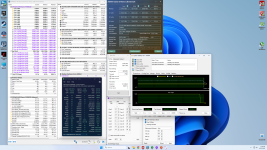
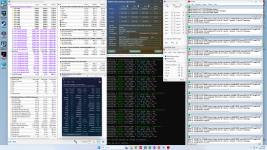

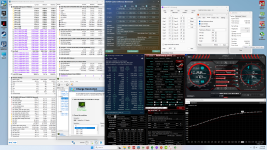
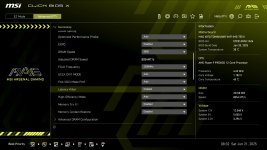

![MSI_Overclocking_[2025-06-23-19-49-04].png MSI_Overclocking_[2025-06-23-19-49-04].png](https://www.hardwareluxx.de/community/data/attachments/990/990825-98eefd9f33c9d0b1ae1ae377d407b103.jpg)
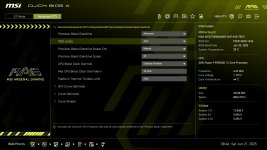
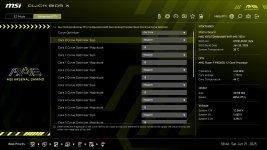


 - Die Fury sind halt schon seit so 2 Jahren am Markt. Die GSkill werde ich wohl nehmen. Die Fury sind nur gerade im "Angebot" müsste ich halt zeitnah kaufen.
- Die Fury sind halt schon seit so 2 Jahren am Markt. Die GSkill werde ich wohl nehmen. Die Fury sind nur gerade im "Angebot" müsste ich halt zeitnah kaufen.

